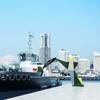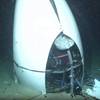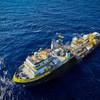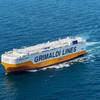A New Chapter in Naval Shipbuilding
As a resounding endorsement of its long-term commitment to shipbuilding in the U.K., Vosper Thornycroft (VT) has created a state-of-the-art ship production facility within Portsmouth Naval Base. Having recently attained preliminary operational status through steel cutting on 295-ft. (90-m) transport barge, the 33-acre naval shipbuilding yard is set to play a key role in the construction of the Royal Navy's next generation of destroyers while extending VT's overall build capabilities and market reach.
It has been some decades since Britain last saw the opening of a new yard of any significant size, and VT's initiative ensures a future for the industry in southern England. The $82.2-million project is all the more impressive for the fact that it has been achieved with no call on the public purse, whether at central, regional or local government level.
Through its emphasis on automated processes, fully under-cover fabrication and assembly, and optimized workflow and logistics, the new yard should enable VT to boost productivity by as much as 20-percent relative to operations at the group's Woolston yard in Southampton. Woolston is to be closed, and the scheduled run-down in work envisions VT's wholesale departure by March next year.
The move provides the shipbuilding and support services group with the resources to attract contracts on the home and overseas markets for a much broader range of business than could be handled at space-constrained Woolston. The Portsmouth site offers room for expansion, a fact that is particularly salient to VT's aspirations to a stake in the program for the Royal Navy's new aircraft carriers (CVF).
Key elements of VT Shipbuilding's Portsmouth facility are the 426,5-ft. (130-m) unit construction hall and ship assembly hall, and the refurbished, 10,000-sq. m. steel production hall. The ship assembly hall stands on an infilled drydock, reclaimed using 100,000-tons of marine-dredged material to provide the foundation for the massive new structure. The site also has at least one drydock that can be used specifically for ship outfitting.
The investment at Portsmouth was made possible by VT's contract to construct and outfit the forward section, funnel and masts for each of the six Type 45 destroyers ordered to date by the U.K Ministry of Defense. The ship sections will be transported by barge to BAE Systems' Scottish yards for final assembly. Production work on the series is scheduled to start later this year. In addition to constructing blocks for the destroyers and potentially other vessels, VT is looking to secure orders, which would enable the concurrent building of whole vessels, such as patrol ships, corvettes and other tonnage.
On the export market, VT has been shortlisted to supply, under a technology transfer deal, up to seven patrol vessels of varying sizes to the New Zealand Navy, and is also bidding for three 262-ft. (80-m) ocean patrol vessels sought by Oman. The group has completed much of its share of work under a technology transfer agreement with the Greek shipyard Elefsis to supply three fast attack craft for the Hellenic Navy, and is in discussions concerning two follow-on craft and a new corvette.
VT Shipbuilding stands to benefit from the announcement by the U.K. Secretary of State for Defense in January to place a contract with BAE Systems in partnership with Thales to design and deliver two new aircraft carriers. At the time, the Secretary of State for Defense indicated his belief that the carriers could be built by a combination of four yards, including VT at Portsmouth. VT is closely involved in talks with the BAE Systems/Thales team about both the level and nature of work it is best placed to carry out under the program, and is hoping to attract around 20-percent of the production hours as well as participating in the design and support activities.
Phase two of the development of the Portsmouth premises will center on the elongation of the ship assembly hall by a further 230- to 656 ft. (70-to 200 m).
Success in winning work on the CVF program would lead to the implementation of a third phase of development. This could entail a third shipbuilding bay up to (190 m), to be built on the site of an adjoining drydock, which would be filled in to provide the platform for construction.
VT is also investigating the possible use of fast catamaran technology in application to U.K. military logistical requirements.
Integration the Theme
There is an ever-stronger case for truly functional integration in application to shipboard systems, on efficiency, reliability and safety grounds. As those at the sharp end know only too well, there is a world of difference between a package of assorted parts, albeit brought together in workmanlike fashion, and a system, which has been designed and crafted from the outset so that each and every element is optimized in relation to every other element. Advances in interfacing technology have had a signal influence on the development of functionally integrated systems, and the improvements can clearly be seen on the bridges and in the engine control rooms of modern ships worldwide. Organizations which span a wide range of products serving the marine market have sought to expand and reinforce their offering not only by adding to the portfolio but also by strengthening the capability to provide integrated solutions.
Towards that end, the multi-faceted Rolls-Royce group is developing its own dynamic positioning (DP) technology, promising a package integrated in such a way that the hydrodynamic, mechanical, electrical, electronic hardware and software constituents work in the greatest possible harmony.
With an eye initially to market demand from the offshore industry, and drawing on its legacy, Scandinavian companies' long experience in designing and equipping vessels built to the various IMO DP classes, Rolls-Royce intends to provide single DP1 systems through to redundant systems meeting DP2 and DP3 criteria. A module-based approach, as regards both software and hardware components, will increase flexibility and facilitate DP system upgrades over the course of a vessel's life.
The move is regarded as a logical extension of the group's business in the field of thrusters, rudders, propellers and associated control systems. The DP technology drive is in keeping with Rolls-Royce's marine automation strategy, based on the concept of a common control platform. Aspects of the latter are already being applied in the new MT30 marine gas turbine and Bergen diesel engine control systems, and in the integration of propulsion control systems, as expressed in a new joystick about to enter service. The initiative will also employ know-how from the group's propulsion and automation products that are now interfaced with DP controls from third parties.













